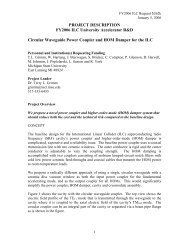The Physics of Dance - University of Illinois High Energy Physics ...
The Physics of Dance - University of Illinois High Energy Physics ...
The Physics of Dance - University of Illinois High Energy Physics ...
You also want an ePaper? Increase the reach of your titles
YUMPU automatically turns print PDFs into web optimized ePapers that Google loves.
<strong>The</strong> <strong>Physics</strong> <strong>of</strong> <strong>Dance</strong><br />
George Gollin, UIUC<br />
Dede Cole, Centennial HS<br />
Saturday <strong>Physics</strong> Honors Program<br />
<strong>University</strong> <strong>of</strong> <strong>Illinois</strong> at Urbana-Champaign<br />
November 10, 2001
Today...<br />
•Introduction<br />
•Some physics vocabulary<br />
•Net force: adding forces<br />
•More physics vocabulary<br />
•Static balance<br />
•Balance while turning<br />
•<strong>The</strong> physics <strong>of</strong> turns<br />
•Jumps (and black holes...)<br />
2
How’d we get ourselves into this?<br />
•George’s story<br />
•Dede’s story<br />
Introduction<br />
Some statements about dance technique can<br />
be restated using a physics vocabulary…<br />
Lifts “feel” the way they do for the same<br />
reason that a large star will collapse to form<br />
a black hole...<br />
3
Some <strong>Physics</strong> Vocabulary<br />
• Velocity ( ): how fast and in what<br />
direction something is moving.<br />
v ! p !<br />
• Momentum( ): <strong>The</strong> magnitude <strong>of</strong> an<br />
object’s momentum gives v ! an indication<br />
<strong>of</strong> how hard it is to bring to a stop.<br />
! !<br />
momentum = mass × velocity: p=<br />
mv<br />
• Force: Just like you’d think. It’s a push,<br />
characterized by a magnitude (how hard)<br />
and a direction.<br />
4
Force changes momentum<br />
• <strong>The</strong> harder you push the more rapidly<br />
the momentum changes.<br />
• <strong>The</strong> longer you push the greater the total<br />
change in momentum. v ! !<br />
• <strong>The</strong> equation: !<br />
∆ p=<br />
F∆t<br />
A force can change an object’s speed<br />
and/or direction <strong>of</strong> motion.<br />
5
Adding forces<br />
Cart feels two forces:<br />
•gravity: downwards<br />
•push from track: up & to-the-left<br />
Net force<br />
force from air track<br />
v ! v !<br />
force from gravity<br />
<strong>The</strong> net force causes the change in the cart’s<br />
momentum.<br />
Forces on a dancer: gravity (down), support<br />
from floor (up), friction from floor (sideways)<br />
6
More <strong>Physics</strong> Vocabulary<br />
• Angular velocity ( ): how fast<br />
something spins and in what direction<br />
its rotation axis points.<br />
ω ! L !<br />
• Angular momentum( ): <strong>The</strong> magnitude<br />
v ! <strong>of</strong> an object’s angular momentum gives<br />
an indication <strong>of</strong> how hard it is to bring to<br />
a stop.<br />
7
Even More <strong>Physics</strong> Vocabulary<br />
• Large rotational inertia ( "<br />
I ), spinning<br />
slowly or small rotational inertia,<br />
spinning rapidly… both are hard to stop.<br />
angular momentum = rotational inertia × angular velocity<br />
• Angular velocity<br />
• angular momentum<br />
• rotational inertia<br />
v ! "!<br />
! L<br />
=<br />
Iω<br />
ω<br />
8
Still More <strong>Physics</strong> Vocabulary<br />
• Centrifugal force: Effective force pushing<br />
something to the outside <strong>of</strong> a turn.<br />
v ! v !<br />
centrifugal force<br />
doubling ω quadruples the centrifugal force…<br />
doubling the turn’s radius doubles the force.<br />
9
Even Still More <strong>Physics</strong> Vocabulary<br />
• Torque ( τ ! ): “<strong>of</strong>f center” forces which<br />
can cause something to spin.<br />
v ! v !<br />
Torque ≠ 0<br />
Net force = 0<br />
Torque ≠ 0<br />
Net force ≠ 0<br />
Torque ≠ 0<br />
Net force ≠ 0<br />
10
About torque...<br />
Torque changes angular momentum:<br />
• <strong>The</strong> harder you push, the more quickly<br />
the object “spins up.”<br />
• <strong>The</strong> further from the spin axis you apply<br />
the forces, the more quickly the object<br />
spins up.<br />
• <strong>The</strong> longer you push, the greater the<br />
total change in angular momentum.<br />
• If no torque is applied to a rigid object,<br />
its spin axis doesn't wobble.<br />
v ! v !<br />
11
Static Balance<br />
We all know what it means... in physics terms:<br />
• Net force is zero (otherwise your momentum<br />
would change: you might fall)<br />
• Net torque is zero (otherwise your angular<br />
momentum would change: you might tip<br />
over)<br />
v ! v !<br />
1 kg 1 kg<br />
1 kg<br />
1 kg 1 kg<br />
equal masses, equal distances<br />
to center <strong>of</strong> gravity<br />
unequal masses, unequal<br />
distances to center <strong>of</strong> gravity<br />
12
Center <strong>of</strong> gravity<br />
Just like you'd think. You can balance around<br />
this point.<br />
Reason for the name: net effect <strong>of</strong> gravity on<br />
an object (a dancer) is the same as if it were<br />
only acting at the c.g., and not on all parts <strong>of</strong><br />
the object.<br />
v ! v !<br />
13
Forces on a Balanced <strong>Dance</strong>r<br />
Gravity (pulls down, acts at c.g.) + support<br />
from floor (pushes up, acts at feet)<br />
v ! v !<br />
Keith Roberts (ABT) in<br />
<strong>The</strong> Rite <strong>of</strong> Spring,<br />
photo by Roy<br />
Round (New York)<br />
Forces sum to zero; both forces "point through"<br />
the dancer's center <strong>of</strong> gravity, so torque is zero.
More complicated example<br />
v ! v !<br />
Forces on each dancer sum to zero. Though<br />
some forces are “<strong>of</strong>f-center” torques also sum<br />
to zero.<br />
Sandra Brown and Johann Renvall (ABT) 15in Airs,<br />
photo by Nancy Ellison
Staying Balanced<br />
Feet flat on the floor<br />
Balance is<br />
On one foot<br />
OK anywhere<br />
in here<br />
v ! v !<br />
Staying balanced: center <strong>of</strong> gravity remains<br />
directly above the area <strong>of</strong> contact with the<br />
!<br />
floor. (Otherwise τ ≠ 0: you'd tip over.)<br />
16
Staying Balanced<br />
Smaller floor contact area (en pointe, for<br />
example) makes balance more difficult.<br />
Maintaining balance:<br />
•shift foot to move floor contact area<br />
•adjust arms/legs/torso to move c.g.<br />
v ! v !<br />
17
Balance While Turning<br />
Two distinct "physics domains" here:<br />
•slow turns: maintain static balance<br />
•fast turns: rotation axis shouldn't wobble<br />
(much)<br />
v ! v !<br />
18
Balance While Turning<br />
Not all positions which are statically<br />
balanced can be held in a turn.<br />
An example:<br />
centrifugal<br />
force<br />
centrifugal<br />
force<br />
v ! v !<br />
contact point<br />
with floor<br />
stays fixed<br />
Centrifugal forces exert a torque, throwing the<br />
dancer <strong>of</strong>f balance.<br />
19
Balance While Turning<br />
Shift center <strong>of</strong> gravity to maintain dynamic<br />
(but not static) balance:<br />
v ! v !<br />
20
Reminders:<br />
<strong>The</strong> <strong>Physics</strong> <strong>of</strong> Turns<br />
!<br />
• L " is angular momentum<br />
• I is rotational inertia<br />
ω !<br />
• is angular velocity v ! • τ ! is torque<br />
! "!<br />
• L = Iω<br />
! !<br />
• ∆ L = τ∆t<br />
21
I "<br />
<strong>The</strong> <strong>Physics</strong> <strong>of</strong> Turns<br />
indicates how hard it is to start something<br />
spinning (just as mass is an indication <strong>of</strong><br />
how hard it is to start something moving).<br />
! !<br />
!<br />
∆ L= τ∆t: if no torque is applied L must be<br />
constant.<br />
v ! v !<br />
! "!<br />
L = Iω ... if no " torque is applied:<br />
• Decreasing I will increase ω !<br />
"<br />
• Increasing I will decrease ω !<br />
22
Calculating Rotational Inertia I "<br />
"<br />
• Greater mass → " greater I . (Doubling the<br />
mass doubles I .)<br />
• Mass placed " farther from rotation axis →<br />
v ! greater I . (Doubling " the distance<br />
quadruples I .)<br />
"<br />
• I = mr<br />
2<br />
(one mass)<br />
"<br />
•<br />
2 2<br />
I = mr + m r + # (several masses)<br />
11 2 2<br />
23
"<br />
Increasing I Decreases Spin Rate<br />
r r × 2<br />
4 rpm 1 rpm<br />
quadruples in the figure. v ! I " Before... ...and after<br />
Because <strong>of</strong> “conservation <strong>of</strong> angular<br />
momentum” you can change the speed <strong>of</strong> a<br />
turn when en pointe by extending or retracting<br />
arms and legs.<br />
No torque is involved!<br />
24
"<br />
Increasing I Decreases Spin Rate<br />
v ! v !<br />
larger I,<br />
smaller ω<br />
smaller I,<br />
larger ω<br />
25
Friction and Torque<br />
Friction between the floor and your foot (or<br />
feet) can also generate a torque. Swinging a<br />
leg going into a turn works like this:<br />
v ! v !<br />
You push on the floor one way, the floor<br />
pushes back the other way.<br />
26
<strong>The</strong> <strong>Physics</strong> <strong>of</strong> Jumps<br />
Gravitational force depends on mass:<br />
• More massive → greater gravitational pull<br />
• Mass is to gravity like electric charge is to<br />
electrostatics. In electrostatics: the larger the<br />
v ! electric charge something has, the greater the<br />
force it feels in an electric field.<br />
Momentum also depends on mass: the greater<br />
your mass, the harder it is to stop moving at a<br />
particular speed. (Recall: p = mv)<br />
27
<strong>The</strong> <strong>Physics</strong> <strong>of</strong> Jumps<br />
This is very curious. Why should an<br />
object's momentum/velocity relationship<br />
have anything at all to do with the<br />
gravitational pull on that object?<br />
v ! v !<br />
(Doubling an object's mass both doubles<br />
its momentum and doubles the strength <strong>of</strong><br />
the gravitational force it experiences.)<br />
28
<strong>The</strong> <strong>Physics</strong> <strong>of</strong> Jumps<br />
<strong>The</strong> equivalence <strong>of</strong> "gravitational" and<br />
"inertial" mass gives rise to Einstein's<br />
General <strong>The</strong>ory <strong>of</strong> Relativity. Black holes,<br />
curved spacetime, and so on!<br />
v ! v !<br />
If they were not equivalent, dance technique<br />
associated with jumps would need to be<br />
different from what it actually is.<br />
29
Gravity...<br />
…is the only force acting on a dancer in midair.<br />
Recall: net effect <strong>of</strong> gravity is the same as if<br />
it were only acting at the dancer’s center <strong>of</strong><br />
gravity.<br />
! !<br />
Gravitational force: F = mg ( g ! is constant)<br />
v !<br />
Force and momentum:<br />
! ! !<br />
∆ p= m∆ v = F∆t<br />
30
Gravitational acceleration...<br />
…is independent <strong>of</strong> mass.<br />
Anything you drop speeds up at the same<br />
rate; anything thrown straight up slows down<br />
at the same rate.<br />
v !<br />
Vertical speed changes by 32 feet per second<br />
(about 22 mph) for each second spent in the<br />
air.<br />
31
Gravity Only Influences Vertical<br />
(Not Horizontal) Motion<br />
Velocity <strong>of</strong> a dancer’s center <strong>of</strong> gravity vs.<br />
time during a jump:<br />
vertical velocity<br />
take <strong>of</strong>f<br />
going up coming down<br />
time<br />
land<br />
v !<br />
horizontal velocity<br />
time<br />
<strong>Dance</strong>r’s vertical motion slows, stops, changes<br />
direction as dancer rises, then falls.<br />
32
Trajectory in a Jump<br />
Height vs. time is a parabola; horizontal<br />
distance vs. time is a straight line:<br />
vertical position<br />
going up<br />
coming down<br />
time<br />
v !<br />
horizontal position<br />
time<br />
33
Trajectory in a Jump<br />
<strong>The</strong> dancer’s center <strong>of</strong> gravity moves along a<br />
trajectory which is also a parabola. For a 2 foot<br />
rise in the height <strong>of</strong> the c.g. and a 10 ft/sec<br />
horizontal velocity we see the following:<br />
v !<br />
2 ft<br />
7.1 ft<br />
34
Illusions in a Jump<br />
By raising his/her legs (changing the distance<br />
between the c.g. and his/her head)...<br />
v !<br />
<strong>The</strong> dancer can create an illusion <strong>of</strong> floating...<br />
35
Illusions in a Jump<br />
<strong>The</strong> dancer can create an illusion <strong>of</strong> floating...<br />
1.3 ft<br />
v ! 2 ft<br />
<strong>The</strong> vertical motion <strong>of</strong> the head is smaller than<br />
the vertical motion <strong>of</strong> the center <strong>of</strong> gravity.<br />
36
Half the duration <strong>of</strong> the jump is spent between<br />
the points indicated by the arrows; the height<br />
<strong>of</strong> the dancer's center <strong>of</strong> gravity only changes<br />
by 6 inches during this time.<br />
Illusions in a Jump<br />
Top <strong>of</strong> the dancer’s head<br />
spends half the time <strong>of</strong> the<br />
jump between these two points<br />
v !<br />
Half the time in the jump is spent<br />
between these two points
<strong>Dance</strong> is an Art<br />
• <strong>Physics</strong> does not “explain” dance<br />
• <strong>The</strong> reaction <strong>of</strong> the audience to dance is not<br />
“enhanced” by knowing the physics<br />
• <strong>The</strong>re are interesting parallels between some<br />
ideas <strong>of</strong> current interest in the humanities<br />
and those <strong>of</strong> modern physics (e.g. the<br />
blurring <strong>of</strong> boundaries between a thing and<br />
its environment)<br />
• It is interesting to see where dance/physics<br />
vocabularies overlap.<br />
38
With More Time...<br />
Time permitting, it would be fun to<br />
investigate some <strong>of</strong> the following:<br />
• dancing with a partner<br />
• effects relating to body size<br />
• impacts and stress injuries<br />
• the connection between “good technique”<br />
and injury prevention<br />
39
Acknowledgements and References<br />
<strong>Dance</strong> faculty at UIUC:<br />
Linda Lehovec, Rebecca Nettl-Fiol, Sean Sullivan, Renée Wadleigh,<br />
Erica Wilson-Perkins<br />
<strong>Dance</strong> faculty at Hope College (Michigan):<br />
Linda Graham<br />
More information:<br />
Kenneth Laws and Cynthia Harvey, <strong>Physics</strong>, <strong>Dance</strong>, and the Pas de<br />
Deux, Schirmer Books, New York, 1994.<br />
http://www.uiuc.edu/ph/www/g-gollin/dance/dance_physics.html<br />
40



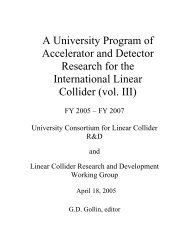
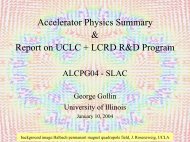
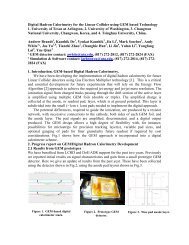
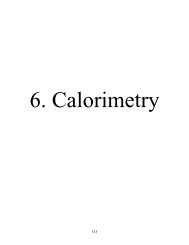

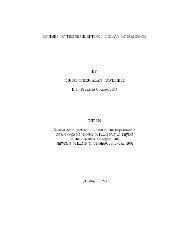
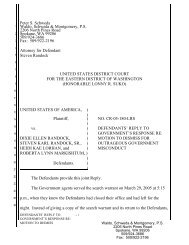
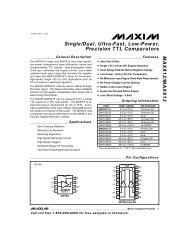
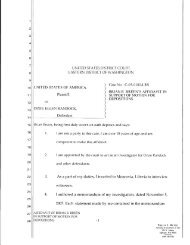
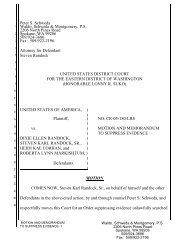
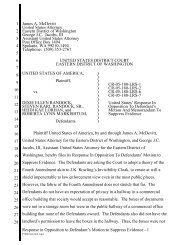
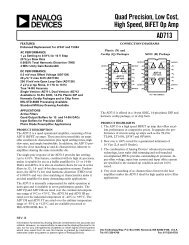
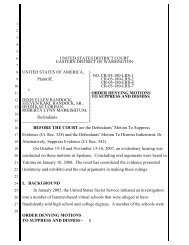
![Linear Collider [Accelerator] Overview](https://img.yumpu.com/33867705/1/190x143/linear-collider-accelerator-overview.jpg?quality=85)
